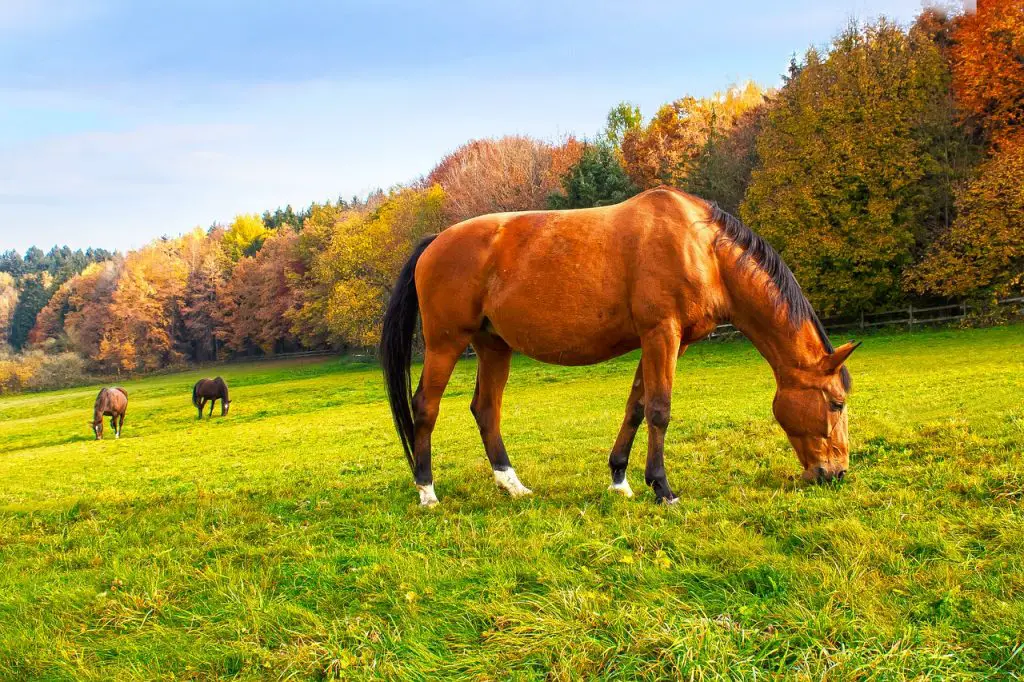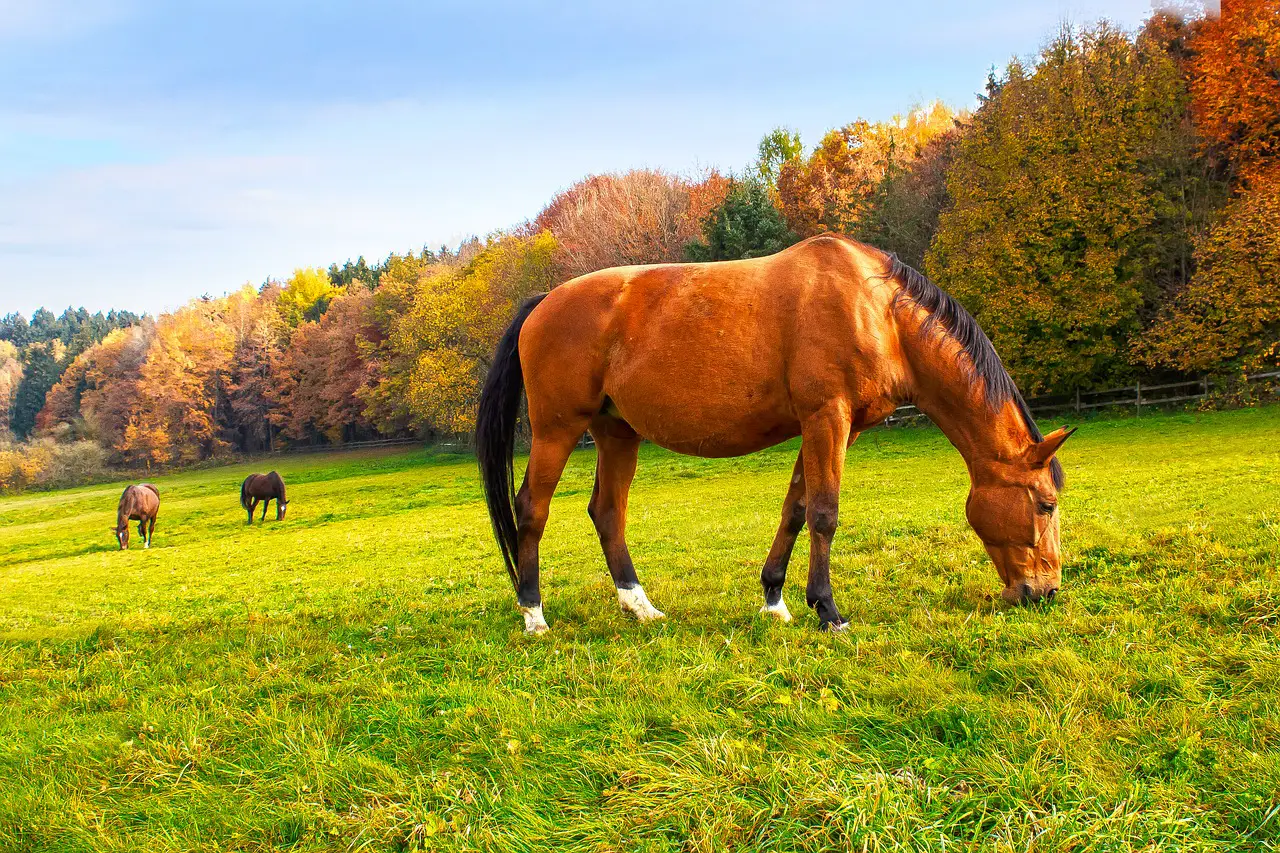Last Updated on February 23, 2022 by Allison Price
Horses cannot eat fresh-cut grass as they don’t properly chew it. This can lead to serious health problems. Horses can also get sick from ingesting clumps of cut grass. This is because it attracts bacteria and mold, which can cause severe and sometimes fatal stomach issues.
However, grazing horses can still enjoy cut grass. The grass must dry properly before it can be used again. Hay is made of cut grass. However, it’s dried and then processed before being baled. Horses should not eat fresh grass clippings.
Grass for Horses: Why it’s Essential, and the Different Types. Now, let’s learn why grass clippings are not recommended for horses.
Why cutting grass is bad for horses
Horses are allowed to graze in their natural environment. They take the time to find suitable grass and then grind it down before they eat more. Slow grazing is the way horses are programmed to consume and digest food.
They are attracted to the grass if they have access to large quantities of it. The grass is not chewed properly and is swallowed too fast for their bodies to handle.

Wet grass clippings can be thought of as horse chewing gum. Large chunks have a squishy texture, a lot of moisture and a high sugar content. Horses won’t be able to tell when it is time to stop eating.
Eating grass clippings can lead to health problems
It is best to remove horses from the pasture after cutting grass. Paddocks can be used to keep horses from the grass. You can also use a grazing mozzle for control.
Horses will find ways to get somewhere they don’t want to be. Here are some possible health problems that may occur if your horse eats fresh-cut grass.
Colic
Mold thrives in warm and moist environments. Mold can accumulate on grass clippings that are still damp. This is a real concern. Colic is a condition in which a horse consumes moldygrass.
Colic can be defined broadly as abdominal pain. There are many causes, but overeating is the most common. In the stomach, large amounts of grass clippings that aren’t dried yet, remain undigested and ferment. Gas can form from the undigested grass, which causes gastric pressure and pain.
Depending on the source and manner of food, there are many ways to treat colic horses. A vet can help you diagnose and manage colic quickly.
You can use electrolytes to hydrate the horse, or put it on medication to combat colic symptoms. If the food gets stuck in its intestines, surgery may be necessary. This is a brief overview of how to manage colic in horses.
Choke
Choke is when food becomes stuck in horse’s stomach tube (tube that connects the stomach and throat). If the food or liquid gets into the lungs, it can cause infection.
Choking is caused by eating food that hasn’t been properly chewed. You may notice changes in your horse’s behavior if it develops choke from eating cut grass.
Horses may lose interest in their feed. The horse may try to get rid of the food by coughing or shaking its head. You should also be alert for excessive drooling and the release of mucus from the nose.
You should not give your horse water or feed if you suspect choke may have developed. Choke treatment requires special attention from the vet. He will usually sedate your horse and then use drugs to ease the condition or insert a tube through the nostrils.
Laminitis
A high amount of carbohydrate content in grass means that excessive consumption of freshly cut grass can lead to an overdose of sugar. Sugar overload can cause a chain reaction in your gut, which can lead to chronic feet inflammation.
laminitis is also known as founder. In severe cases, it can cause permanent paralysis and even death. Contact the vet immediately if you suspect your horse may be at risk of foundering.
Is it strangely walking, or walking on needles? Are you noticing a sudden reluctance to eat your feed? Laminitis can be detected by even minor changes, such as a change in its foot or unusual warmth in the hoofs.
Your vet will recommend a diet for horses suffering from laminitis. Your horse must be kept in its stall and not allowed to move around. You should ensure that your horse has a thick layerer bedding. It will most likely be laying down quite a bit.
Horse owners often believe that euthanasia should be the final option for foundered horses. However, there are some options for horses who can be saved if they receive proper treatment and time. This article on horse laminitis, and how to treat it, is highly recommended.
Can horses eat dry grass clippings
My friend is a veterinarian and tells me she deals with horses that have become sick from eating fresh-cut grass quite often. In fact, one study identified digestive diseases as the third leading cause of death for horses.
Horses will eat small amounts of dry grass clippings if they are given in small quantities. Wet grass chunks can cause health problems for horses if they get stuck in their throats or intestines.
How long can you leave the grass to be cut before you can feed it to your horse.
My pastures are always trimmed, which is why my horses love to graze. It is important that I know when the grass will dry so they can eat it.
Most grass should dry within one day after it has been cut and spread out in the sunlight. However, grass left in clumps in humid conditions can take several days to dry out before it’s safe to feed horses.
The drying time of cut grass depends on many factors, such as the time it has been exposed to sunlight, temperature, humidity and the type of grass.
We don’t all have the ability to test our grass with sophisticated equipment. Therefore, we must judge our grass by its feel, appearance, and weight.
The drying time of your grass can be controlled. Cut grass must lose 70-80% of its moisture, whereas uncut grass only needs to dry for about 70% to 80%. The grass at 20-30 percent moisture is usually safe from mold. It is tough enough to be chewed by horses before they eat it.
It is not difficult for me to tell when grass is dry enough to feed horses. I simply grab a handful of grass and squeeze it hard. You shouldn’t feel any moisture in the grass if it is dry.
How can you dry your grass clippings quicker?
Through trial and error, I have learned a few key tips that will help grass clippings dry faster. These tips are important because my horses depend on dry grass.
You should mow your grass when it is dry. Don’t cut your grass too early in the morning if there is still dew. It’s better to wait until it has rained recently, or if the weather is foggy before you cut your grass.
Wet grass has a higher chance of clumping together, and takes longer to dry. These grass clippings clumps can be harmful for your horse, and are susceptible to mold and bacteria.
Wet grass is less efficient at cutting as evenly as dry grass. You may have a less smooth experience mowing because it can clog your chute.
Spreading grass clippings thinly is better than narrow swaths. To remove any clumps, make sure to check your grass after you have finished mowing. This will allow the clippings to dry faster and keep the grass’ integrity longer.
Conclusion
It is a good idea to know how many grass clippings your horses eat. It’s best to keep horses away from pasture grass that has been mowed recently, if it is still damp.



